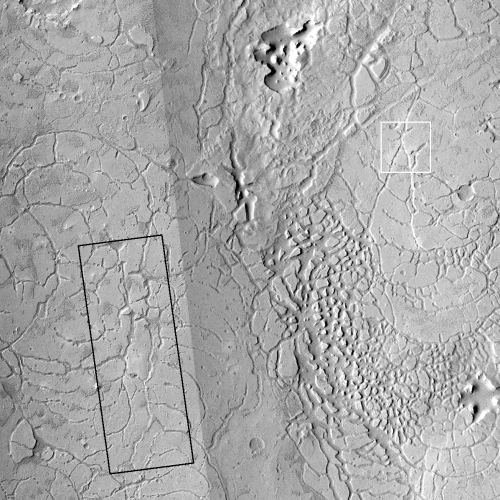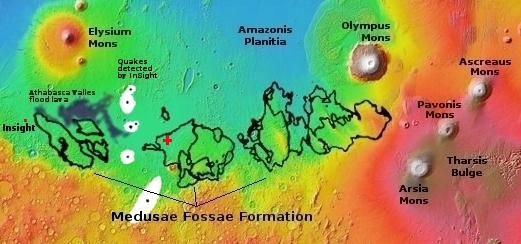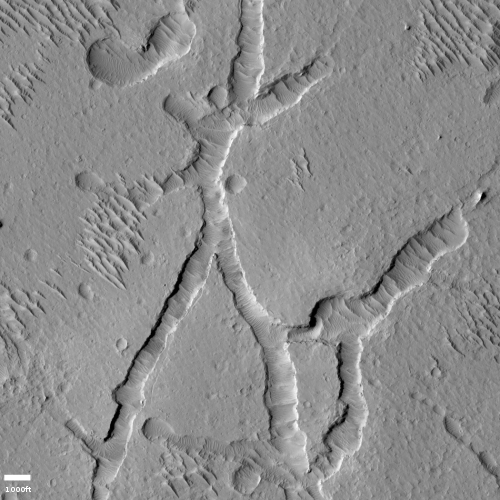Cracks, chaos, and maybe caves in one place on Mars

Click for higher resolution. Original images found here and here.
Today’s cool image to the right is a mosaic I have made from two images taken by the context camera on Mars Reconnaissance Orbiter (MRO), showing a most intriguing region on Mars dubbed Avernus Cavi, located in the large volcanic plain called Elysium Planitia between the giant volcanoes Elysium Mons and Olympus Mons, a region I like to call Mars’ volcano country.
The mosaic shows in one picture much of the typical terrain in Avernus Cavi. We see many linear depressions or cracks, created when the ground stretched and cracked at weak points. We also see many depressions that suggest sinkholes, places where the surface sagged down because of a void below ground.
The area of knobs and mesas in the picture’s southeast quadrant is very typical Martian chaos terrain, the later result of long term erosion of these cracks and depressions.
The white box shows the area covered by the image below.
The photo, cropped and reduced to post here, covers a section of a March 2020 MRO high resolution picture of these cracks, posted today as that camera’s picture of the day. The short caption:
This image features small collection of cave candidates in Avernus Cavi, located in Elysium Planitia. These candidates are located at the base of scarps formed by extensional fracturing. We might be able to resolve rim and floor textures as finely as possible to verify if any caves are indeed present.
In other words, no cave entrances have as yet been identified, but scientists are taking high resolution images in an effort to find them. The assumption is that the cracks and fractures are much deeper than what we can see on the surface, and that there are likely voids below.
The black rectangle in the mosaic above shows the area covered by another MRO high resolution image, taken in 2015 and labeled “Lines of Pits in Avernus Cavi Region.” What struck me about that image was how much the depressions appear to reflect a river tributary system. This is not we are looking at, but that’s what it invokes. Like the first picture above, the cracks occur because the land has become stretched, opening up fissures along fault lines.

As shown by the red cross in the overview map to the right, Avernus Cavi is located within the huge volcanic ash deposit called the Medusa Fossae Formation, thought to be the source of most of Mars’ dust. This is also at the Martian equator, so the surface in this region is very dry, with most features the result of some volcanic process.
It is also relatively close to the majority of the quakes detected by InSight, suggesting that such cracks and fissures could still be spreading and shifting.
On Christmas Eve 1968 three Americans became the first humans to visit another world. What they did to celebrate was unexpected and profound, and will be remembered throughout all human history. Genesis: the Story of Apollo 8, Robert Zimmerman's classic history of humanity's first journey to another world, tells that story, and it is now available as both an ebook and an audiobook, both with a foreword by Valerie Anders and a new introduction by Robert Zimmerman.
The print edition can be purchased at Amazon or from any other book seller. If you want an autographed copy the price is $60 for the hardback and $45 for the paperback, plus $8 shipping for each. Go here for purchasing details. The ebook is available everywhere for $5.99 (before discount) at amazon, or direct from my ebook publisher, ebookit. If you buy it from ebookit you don't support the big tech companies and the author gets a bigger cut much sooner.
The audiobook is also available at all these vendors, and is also free with a 30-day trial membership to Audible.
"Not simply about one mission, [Genesis] is also the history of America's quest for the moon... Zimmerman has done a masterful job of tying disparate events together into a solid account of one of America's greatest human triumphs."--San Antonio Express-News

Click for higher resolution. Original images found here and here.
Today’s cool image to the right is a mosaic I have made from two images taken by the context camera on Mars Reconnaissance Orbiter (MRO), showing a most intriguing region on Mars dubbed Avernus Cavi, located in the large volcanic plain called Elysium Planitia between the giant volcanoes Elysium Mons and Olympus Mons, a region I like to call Mars’ volcano country.
The mosaic shows in one picture much of the typical terrain in Avernus Cavi. We see many linear depressions or cracks, created when the ground stretched and cracked at weak points. We also see many depressions that suggest sinkholes, places where the surface sagged down because of a void below ground.
The area of knobs and mesas in the picture’s southeast quadrant is very typical Martian chaos terrain, the later result of long term erosion of these cracks and depressions.
The white box shows the area covered by the image below.
The photo, cropped and reduced to post here, covers a section of a March 2020 MRO high resolution picture of these cracks, posted today as that camera’s picture of the day. The short caption:
This image features small collection of cave candidates in Avernus Cavi, located in Elysium Planitia. These candidates are located at the base of scarps formed by extensional fracturing. We might be able to resolve rim and floor textures as finely as possible to verify if any caves are indeed present.
In other words, no cave entrances have as yet been identified, but scientists are taking high resolution images in an effort to find them. The assumption is that the cracks and fractures are much deeper than what we can see on the surface, and that there are likely voids below.
The black rectangle in the mosaic above shows the area covered by another MRO high resolution image, taken in 2015 and labeled “Lines of Pits in Avernus Cavi Region.” What struck me about that image was how much the depressions appear to reflect a river tributary system. This is not we are looking at, but that’s what it invokes. Like the first picture above, the cracks occur because the land has become stretched, opening up fissures along fault lines.

As shown by the red cross in the overview map to the right, Avernus Cavi is located within the huge volcanic ash deposit called the Medusa Fossae Formation, thought to be the source of most of Mars’ dust. This is also at the Martian equator, so the surface in this region is very dry, with most features the result of some volcanic process.
It is also relatively close to the majority of the quakes detected by InSight, suggesting that such cracks and fissures could still be spreading and shifting.
On Christmas Eve 1968 three Americans became the first humans to visit another world. What they did to celebrate was unexpected and profound, and will be remembered throughout all human history. Genesis: the Story of Apollo 8, Robert Zimmerman's classic history of humanity's first journey to another world, tells that story, and it is now available as both an ebook and an audiobook, both with a foreword by Valerie Anders and a new introduction by Robert Zimmerman.
The print edition can be purchased at Amazon or from any other book seller. If you want an autographed copy the price is $60 for the hardback and $45 for the paperback, plus $8 shipping for each. Go here for purchasing details. The ebook is available everywhere for $5.99 (before discount) at amazon, or direct from my ebook publisher, ebookit. If you buy it from ebookit you don't support the big tech companies and the author gets a bigger cut much sooner.
The audiobook is also available at all these vendors, and is also free with a 30-day trial membership to Audible.
"Not simply about one mission, [Genesis] is also the history of America's quest for the moon... Zimmerman has done a masterful job of tying disparate events together into a solid account of one of America's greatest human triumphs."--San Antonio Express-News



I hardly ever comment on them because I have nothing to add, but these Mars pictures and explanations are the biggest reason I visit this site. Just so you know.
markedup2: Thank you. I often wonder if there really is a lot of interest in these cool images, as the number of comments are always far less than the political posts.
Not that it matters. Everything I do on BtB is because it is something that interests me. Which means I will keep posting them, because I enjoy it and doing so gives me some relief from the truly depressing news of the day.